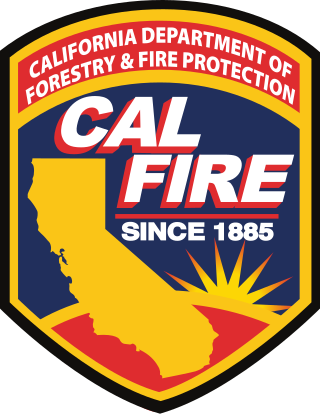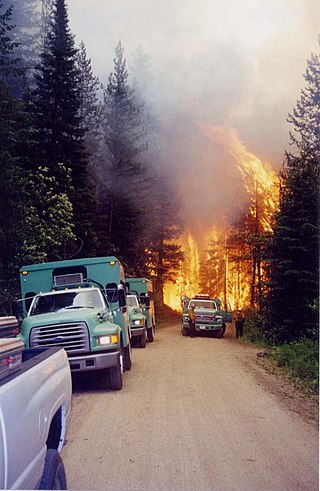This glossary of wildfire terms is a list of definitions of terms and concepts relevant to wildfires and wildland firefighting. Except where noted, terms have largely been sourced from a 1998 Fireline Handbook transcribed for a Conflict 21 counter-terrorism studies website by the Air National Guard.

The California Department of Forestry and Fire Protection is the fire department of the California Natural Resources Agency in the U.S. state of California. It is responsible for fire protection in various areas under state responsibility totaling 31 million acres, as well as the administration of the state's private and public forests. In addition, the department provides varied emergency services in 36 of the state's 58 counties via contracts with local governments. The department's current director is Joe Tyler, who was appointed March 4, 2022, by Governor of California Gavin Newsom.

In the United States, a Shot Crew, officially known as an Interagency Hotshot Crew (IHC), is a team of 20-22 elite wildland firefighters that mainly respond to large, high-priority fires across the country and abroad. They are assigned to work the most challenging parts of the fire and are considered strategic and tactical wildland fire experts. Hotshot crews are considered the most highly trained, skilled and experienced wildland firefighters, along with smokejumpers. They are qualified to provide leadership for initial-attack and extended-attack on wildland fires. Hotshots are trained and equipped to work in remote areas for extended periods of time with minimal logistical support. They are organized by agencies such as the United States Forest Service, National Park Service, Bureau of Indian Affairs, Bureau of Land Management, and state/county agencies; the National Interagency Fire Center coordinates hotshot crews on the federal level.

Wildfire suppression is a range of firefighting tactics used to suppress wildfires. Firefighting efforts depend on many factors such as the available fuel, the local atmospheric conditions, the features of the terrain, and the size of the wildfire. Because of this wildfire suppression in wild land areas usually requires different techniques, equipment, and training from the more familiar structure fire fighting found in populated areas. Working in conjunction with specially designed aerial firefighting aircraft, fire engines, tools, firefighting foams, fire retardants, and using various firefighting techniques, wildfire-trained crews work to suppress flames, construct fire lines, and extinguish flames and areas of heat in order to protect resources and natural wilderness. Wildfire suppression also addresses the issues of the wildland–urban interface, where populated areas border with wild land areas.

The National Interagency Fire Center(NIFC) in Boise, Idaho is the American physical facility which is the home to the National Interagency Coordination Center (NICC), and the National Multi-Agency Coordination group (NMAC or MAC).

The National Wildfire Coordinating Group (NWCG) was formed in the United States as a result of the aftermath of a major wildfire season in 1970, including the Laguna Fire.
In wildland fire suppression in the United States, S-130/S-190 refers to the basic wildland fire training course required of all firefighters before they can work on the firelines.

The Modular Airborne FireFighting System (MAFFS) is a self-contained unit used for aerial firefighting that can be loaded onto both military cargo transport Lockheed C-130 Hercules and Embraer C-390 Millennium, which then allows the aircraft to be used as an air tanker against wildfires. This allows the U.S. Forest Service (USFS) to use military aircraft from the Air National Guard and Air Force Reserve to serve as an emergency backup resource to the civilian air tanker fleet.

Helitack crews are teams of wildland firefighters who are transported by helicopter to wildfires. Helicopters provide rapid transport, enabling helitack crews to quickly respond and assess a wildfire situation. Helitack crews may land near a wildfire or, if equipped and trained, rappel from a hovering helicopter. Once on the ground, crews build firelines using hand tools, chainsaws, and other firefighting tools. They often remain overnight in remote locations. After they have completed their assignment, crew members may pack up to 120 pounds of equipment over difficult terrain to reach a pick-up point. Rappellers often prepare helispots that provide better access to a fire. Helicopter crew members may also perform other duties such as tree falling, firing operations, and managing helibases.

The 2007 California wildfire season saw at least 9,093 separate wildfires that charred 1,520,362 acres (6,152.69 km2) of land. Thirty of those wildfires were part of the Fall 2007 California firestorm, which burned approximately 972,147 acres of land from Santa Barbara County to the U.S.–Mexico border. At the peak of the wildfire activity in October 2007, the raging wildfires were visible from space.
Wildfire suppression in the United States has had a long and varied history. For most of the 20th century, any form of wildland fire, whether it was naturally caused or otherwise, was quickly suppressed for fear of uncontrollable and destructive conflagrations such as the Peshtigo Fire in 1871 and the Great Fire of 1910. In the 1960s, policies governing wildfire suppression changed due to ecological studies that recognized fire as a natural process necessary for new growth. Today, policies advocating complete fire suppression have been exchanged for those who encourage wildland fire use, or the allowing of fire to act as a tool, such as the case with controlled burns.
Wildfire suppression equipment and personnel is part of the science of fire fighting focusing on the use of specialized equipment, training and tactics to effectively control, surround and eventually extinguish a natural cover fire. There are several specially designed tools that through their function and user training, perform specialized tasks that are specific to natural cover firefighting. This is used together in conjunction with the general understanding of the behavior of fire to form a viable plan of attack.
InciWeb is an interagency all-risk incident web information management system provided by the United States Forest Service released in 2004. It was originally developed for wildland fire emergencies, but can be also used for other emergency incidents.

The Thirtymile Fire was first reported on July 9, 2001 in the Okanogan National Forest, approximately 30 miles (48 km) north of Winthrop, Washington, United States. The wildfire had been caused by an unattended campfire that spread rapidly in the hot and dry weather in the Pacific Northwest. Four firefighters were killed when the fire cut off their only escape route out of the narrow canyon.

Wildfires are outdoor fires that occur in the wilderness or other vast spaces. Other common names associated with wildfires are brushfire and forest fire. Since wildfires can occur anywhere on the planet, except for Antarctica, they pose a threat to civilizations and wildlife alike. In terms of emergency management, wildfires can be particularly devastating. Given their ability to destroy large areas of entire ecosystems, there must be a contingency plan in effect to be as prepared as possible in case of a wildfire and to be adequately prepared to handle the aftermath of one as well.

The New Jersey Forest Fire Service (NJFFS) is an agency within the New Jersey Department of Environmental Protection. Founded in 1906 with a focus on wildland fire suppression and fire protection, the Forest Fire Service is the largest firefighting department within the state of New Jersey in the United States with 85 full-time professional firefighting personnel, and approximately 2,000 trained part-time on-call wildland firefighters throughout the state. Its mission is to protect "life and property, as well as the state's natural resources, from wildfire".

Wildfires can happen in many places in the United States, especially during droughts, but are most common in the Western United States and Florida. They may be triggered naturally, most commonly by lightning, or by human activity like unextinguished smoking materials, faulty electrical equipment, overheating automobiles, or arson.

The 1998 Florida wildfires, sometimes referred to as the Florida Firestorm, was a wildfire event involving several thousand separate woodland and mixed urban-rural wildfires which wrought severe damage during the summer months of 1998. Wildfires sparked mainly by lightning threatened to converge into single, vast blazes, crossed natural firebreaks such as rivers and interstate highways, and demanded an unprecedented suppression response of firefighting resources from across the country. Regular activities such as Fourth of July celebrations, sporting events, tourism, and daily life were profoundly interrupted for millions of residents and visitors in the northeastern part of the state.

The Bobcat Fire was a large wildfire in Los Angeles County and one of the major incidents of the 2020 California wildfire season. The fire ignited on September 6, 2020, and burned 115,997 acres (46,942 ha) before it was fully contained by November 27. The Bobcat Fire primarily burned in the central San Gabriel Mountains, in and around the Angeles National Forest, and is one of the largest fires on record in Los Angeles County to date.

The 2022 California wildfire season was a series of wildfires throughout the U.S. state of California. By the end of the year, a total of 7,667 fires had been recorded, totaling approximately 363,939 acres across the state. Wildfires killed nine people in California in 2022, destroyed 772 structures, and damaged another 104. The 2022 season followed the 2020 and 2021 California wildfire seasons, which had the highest and second-highest (respectively) numbers of acres burned in the historical record, with a sharp drop in acreage burned.















